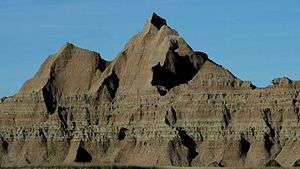Brule Formation
| Brule Formation Stratigraphic range: Rupelian ~33–30 Ma | |
|---|---|
 Brule Formation in Badlands National Park | |
| Type | Geological formation |
| Unit of | White River Formation |
| Underlies | Sharps Formation, Arikaree Formation |
| Overlies | Chadron Formation |
| Thickness | 6–65 metres (20–213 ft)[1] |
| Lithology | |
| Primary | Fine grained clastic rocks |
| Other | Freshwater limestone, Tuff, Sandstone |
| Location | |
| Region | Nebraska, North Dakota, South Dakota, Colorado, Wyoming |
| Country | United States |
The Brule Formation was deposited between 33 and 30 million years ago, roughly the Rupelian age (Oligocene).[2] It occurs as a subunit of the White River Formation in Nebraska, Colorado, North Dakota, South Dakota, and Wyoming.
It is a sequence of fine grained clastic rocks (claystones, mudstones, siltstones) interbeded with freshwater carbonates, volcanic ash (tuff), and sandstone.[1]
The sandstones layers, which are up to 3 metres (9.8 ft) thick, can contain mammalian fossils (e.g. the Fitterer bed). The most important fossils sites are:[1]
- Fitterer Ranch
- Obritsch Ranch
- M&M Ranch
- Little Badlands in Stark County, ND
- Chalky Buttes (including White Butte) in Slope County, ND
Fossil record
Prehistoric catfish, several mammals such as nimravids and hesperocyon and sunfish fossils are known from the Brule Formation in Badlands National Park.[3]
Notable among the local fauna are Bathornithid birds, ranging from the highly varied wetland-dwelling Bathornis species to the gigantic Paracrax.
Fauna
| Fauna reported from the Brule Formation | ||||||
|---|---|---|---|---|---|---|
| Genus | Species | Location | Stratigraphic position | Material | Description | Images |
| Proscalps tertius[4] | Numerous, including upper incisor and molar.[4] | Species holotype likely located here.[4] | ||||
| Hyracodon |
|
SD, ND, NE | Jaw fragments, skulls | Early rhinoceros | ||
| Subhyracodon |
|
NE, SD, ND, WY | Teeth and skulls | Early rhinocers | ||
| Eporeodon |
|
SD | Incredibly rare | Large oredodont | ||
| Leptauchenia |
|
SD, NE | Teeth and skulls | Small Oreodont | ||
| Merycoidodon |
|
SD, ND, NE, WY | Skulls, limb bones, and skeletons | Oreodont | ||
| Poebrotherium |
|
SD, ND, NE, WY | Bones, jaw fragments | Early camel | ||
| Leptomeryx | SD, NE, WY | Teeth | Deer-like mammal | |||
| Archaeotherium |
|
WY | Teeth and skulls | Entelodont | ||
See also
- Paleogene paleontological sites of North America
- Paleogene United States
- White River Formation fossil record fauna
References
- 1 2 3 "Lithostratigraphy, Paleontology, and Biochronology of the Chadron, Brule, and Arikaree Formations in North Dakota". Retrieved 28 February 2013.
- ↑ "Geologic Formations". nps.gov.
- ↑ Hunt, ReBecca K., Vincent L. Santucci and Jason Kenworthy. 2006. "A preliminary inventory of fossil fish from National Park Service units." in S.G. Lucas, J.A. Spielmann, P.M. Hester, J.P. Kenworthy, and V.L. Santucci (ed.s), Fossils from Federal Lands. New Mexico Museum of Natural History and Science Bulletin 34, pp. 63-69.
- 1 2 3 4 Bjork, Philip R. (1975). "Observations on Proscalops tertius (Mammalia: Insectivora) of the Upper Oligocene of South Dakota". Journal of Paleontology. 49 (5): 808–813. JSTOR 1303274.